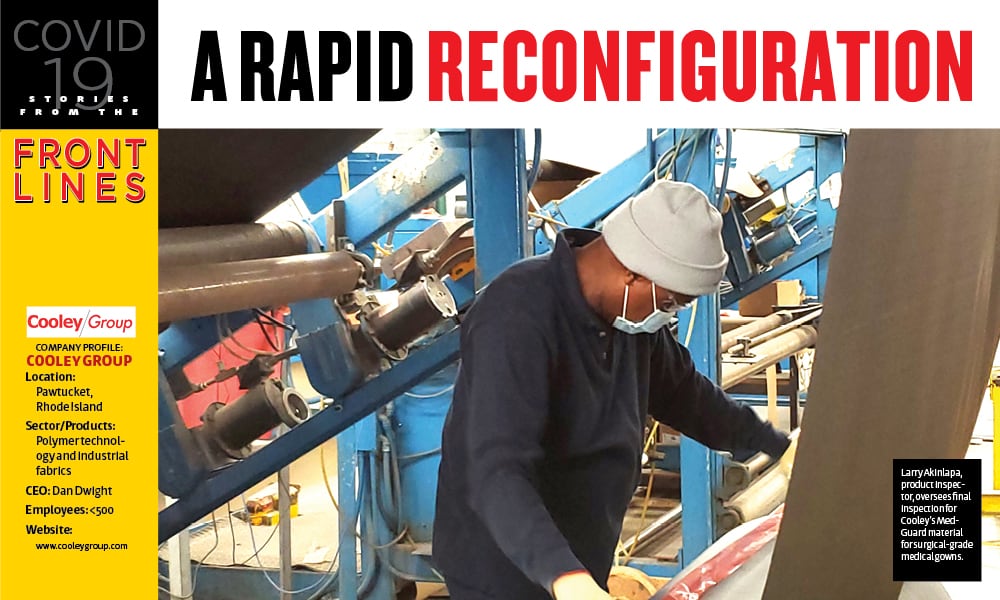
Accelerated product trials enabled Cooley Group to quickly pivot to produce medical gowns.
In the span of just two weeks, Cooley Group, a Pawtucket, RI-
based manufacturer of polymer-based solutions, went from concept development to full-scale production of Level 3 and 4 (surgical) approved medical gowns.
The Cooley team started the process of fabricating medical gowns by modifying existing Cooley products to design launderable medical protection. The modifications were relatively extensive and included, among other things, fabric reconfiguration and compound chemistry specification changes.
Cooley’s Custom Solutions team worked through an accelerated series of trial and error processes, initially at small scale in the company’s R&D lab and then on full production extruders. Understandably, medical supplies must pass rigorous quality control and specification tests. Once we had conducted our own tests internally, Cooley sent sample material to testing labs and customers for their evaluation. Once we achieved Level 3 and 4 (surgical) certifications and customers deemed the product performance satisfactory, Cooley moved into mass production.</p.
“It took us about two weeks to develop the material, perform full testing and certification, and roll it into what is now full-scale production,” said Cooley Group President and CEO Dan Dwight. ‘We’re shipping this out by the truckload.”
A Collaborative Effort
As the coronavirus pandemic intensified, hospitals across the country were under-resourced in urgent, essential healthcare supplies such as personal protective equipment (medical gowns). Cooley’s R&D, Manufacturing and Quality Control teams worked collaboratively across functions to produce and test product variations in an expeditious manner to meet hospitals’ increasing demand for gowns.
Considering Cooley did not manufacture medical gowns prior to COVID-19, the large-scale manufacturing of this new product required modifications to current equipment as well as updated procedures to meet the customization expectations of Cooley customers; in this case, hospitals of coronavirus first responders.
Manufacturing 4.0-enabled modifications to production (beyond the advanced digital tools that enable immediate, cross-functional and cross-facility collaboration) included automated die management and digitized product conversion techniques.
Cooley employed Manufacturing 4.0 techniques includingautomated die management and digitized product conversion.
Numerous Challenges Overcome
In a short time, the Cooley team overcame numerous product development challenges: product performance, as measured by prevention of blood and other fluids from penetrating the gown; product durability, as measured by the number of times the gown can be laundered; and product cost, determined by budget constraints for gowns purchased by hospitals. Cooley overcame the challenges through accelerated product trials, which were supported by a combination of R&D, operations, and third-party testing labs aggregating data and performing analysis.
Now, finished, surgical-grade material is in route (>1 million ft2 per week) to gown fabricators in Rhode Island, Massachusetts, and Louisiana. These gowns will directly serve local hospitals and first responders who are under-resourced in the essential medical supplies they require to manage the COVID-19 pandemic.
Cooley Group is also taking on a variety of other projects to combat COVID-19. One of these involves billboards.
According to the company’s leadership, around 70 percent of the billboards in North America are printed on Cooley-produced material. Through a partnership with the Ad Council and outdoor media companies, Cooley has been donating material and services to the Centers for Disease Control and Prevention and other entities that want to use those billboards for public messaging. M